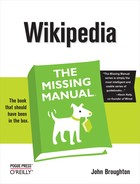Once you’ve mastered the steps in the previous section, you can revert or undo any edit on any Wikipedia page. You can lead a long, happy life without going any further. But if you devote yourself to lots of article repair and restoration, you may appreciate help from some power-user tools, like the three described next.
If you’re an experienced editor who spends a lot of time looking at page histories, consider some customization to enhance the history display:
The user script at User:Stevage/EnhanceHistory.user.js collapses consecutive edits from the same person into one. It also adds a button so that diffs show up on the history page rather than a separate page. (Chapter 21 provides details about getting a user script to work.)
Another minor—but useful—customization often makes it much easier to locate what’s been removed or added in a page change when the change involves just a period, comma, dash or other small single character. Add the following to your monobook.cs page (which you’ll probably need to create, as a subpage, per the instructions on Creating Your Personal Sandbox):
.diffchange {padding: 0px 2px 0px 2px; border: 1px dashed red; margin: 0px 1px
0px 0px}You may find yourself digging through a large number of prior versions of a page, trying to identify exactly who added a given bit of text, and when (for example, to find out if whoever added the text did anything else questionable at the same time). After scrolling through history pages and searching through a large number of versions of the page, you might think, “There has to be a better way.” In fact, you have two alternatives:
An automated tool called WikiBlame, available at http://wikipedia.ramselehof.de/wikiblame.php, digs through the versions for you, spotting what you’re looking for.
Another alternative is to dump up to the last 100 versions of a page into a single document which you can then search. To do so, go to the Special:Export page, and follow the easy instructions there. When you do paste the contents of the export into a document, do so as unformatted text; that’s faster.
Sometimes you’ll want to know the names of the editors who did the greatest number of edits to an article, or other statistics about edits to a particular page. Wikipedia has a number of tools to count edits, sort edits by contributor, generate statistics about contributors to a page, and so on. Two places to start are:
Contributors. (type “en” in the first box, to select the English Wikipedia) http://toolserver.org/~daniel/WikiSense/Contributors.php
Wikipedia Page History Statistics. http://vs.aka-online.de/wppagehiststat (select “en.wikipedia” as the project)
